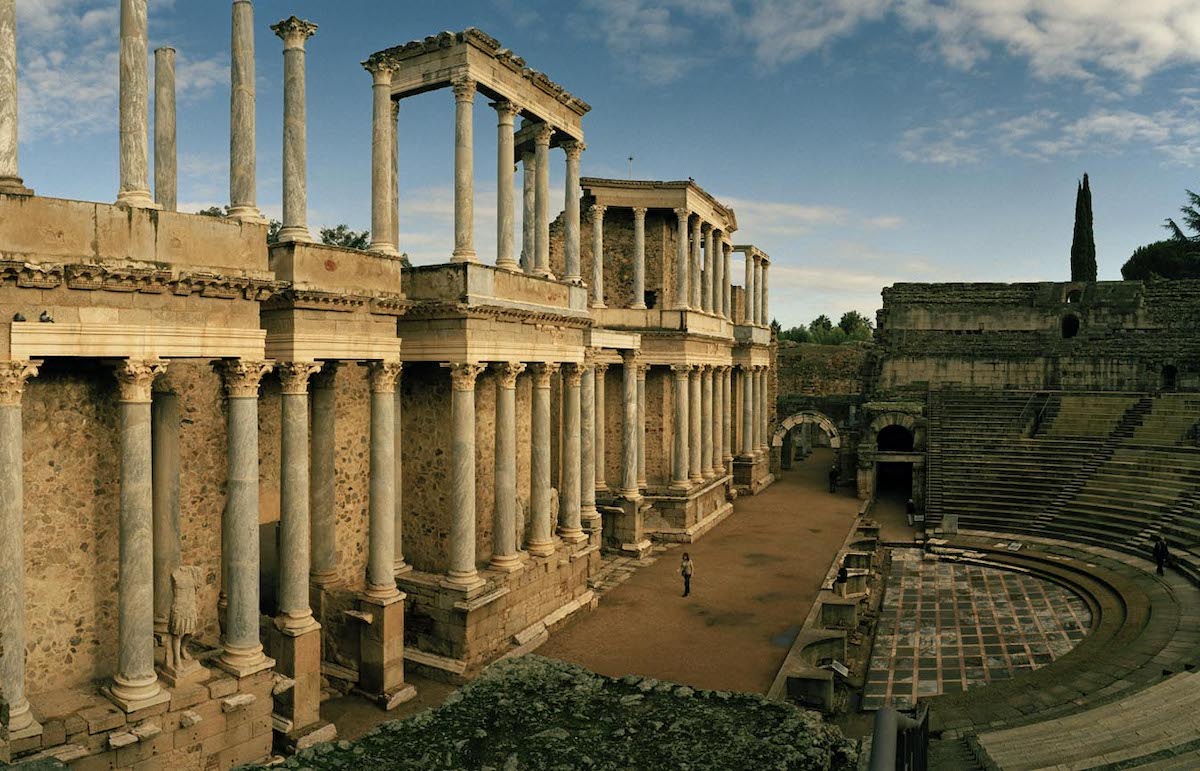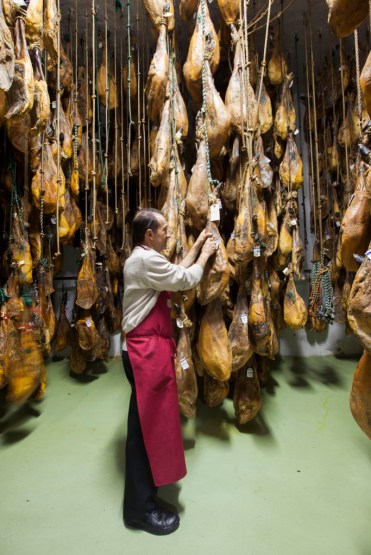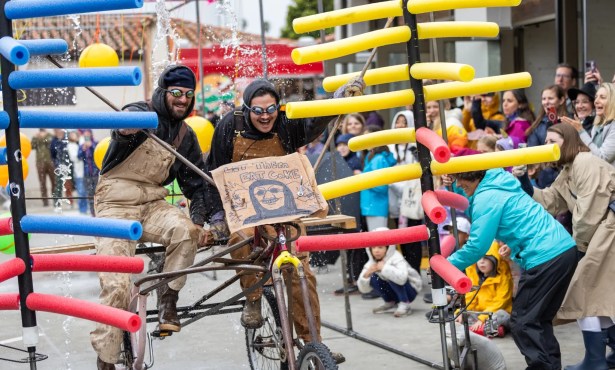Extremadura: An Unspoiled Taste of Spain
Ancient Monuments, Expressive Cuisine, and Authentic Character — but Still Little Visited

Extremadura, in southwestern Spain, is an old-world land that sustains a rich layering of ancient cultures—Tartessians, Celts, Sephardim, Romans, Visigoths, Moors, Berbers. What intrigued us was that this sparsely populated but diverse region received little mention in any of our guidebooks, save for the fact that many of Spain’s conquistadors, including Hernán Cortés and his cousin Francisco Pizarro, were born there. We wanted to know more.
Encompassing the provinces of Cáceres and Badajoz, Extremadura was once, along with most of neighboring Portugal, part of the ancient Roman province of Lusitania, and has been a cultural crossroads for millennia. The Romans farmed and built bridges, roads, and aqueducts. The Moors were also fine farmers and engineers. The Iberian Peninsula was home to Sephardic Jews from the sixth century BCE. For years Moors, Christians, and Jews were culturally, socially, and economically interconnected in the peninsula despite the Christian states’ push southward to wrest territory from the Moors. After 800 years of struggle the Catholic Monarchs, Isabella and Ferdinand II gained control 1492. Christian knights who drove out the Moors were granted huge swaths of land, but they had little interest in farming, and the fields, long ignored, yielded less and less. By the 16th century, Extremadura had become a backwater.

How things change. In 21st-century Extremadura, you can enjoy cutting-edge contemporary art, chic shops, and fine cuisine while exploring ancient ruins literally across the street from each other. Innovative chefs meld earthy and haute cuisine, giving Extremeño food a new expression while embracing agricultural traditions — olive-growing, winemaking, and pig farming — that are thousands of years old. In addition to the celebrated Jamón Ibérico de Bellota (cured ham made from free-roaming pigs fattened on acorns), there is bounty in wild seasonal mushrooms, nuts, game, cheeses, and oak-smoked pimiento peppers. Ancient olive groves produce 30 different varieties of olives and fragrant oils that redefine the color gold. And you can thank the Romans for bringing the grape to ancient Lusitania. It thrives here; Extremadura is Spain’s second-largest wine producer. Ribera del Guardiana, (the banks of the Guardiana river) that nourishes this province, earned its own Denominación de Origen (DO) title in 1999. It includes Tierra de Barros (muddy land) with its hot, flat plains of nutrient rich soil, famous for Garnacha, Tempranillo, and white varietals such Cayetana. For a native Californian like me, Extremadura’s dehesas (oak-studded pasturelands), with their toasted brown-sugar scent of dry grasses and spare pools of shade, are palpably reminiscent of the oak savanna wine country just north of my Santa Barbara home. This is a land of mild winters and summer droughts, and while much of it has been cultivated for more than 2,000 years, large tracts of scrub and woodland have been set aside as wildlife preserves. As a haven for more than 300 species of native and migratory birds, Extremadura attracts birders the world over, particularly in Monfragüe National Park, that is ringed by the triangle of towns that make up the Province of Cáceres: Plascencia, the city of Cáceres, and Trujillo, all part of our itinerary into Extremadura.
***
My husband and I land in Madrid on a clear, brisk November morning, greeted by an orange sunrise. From there, we drive three hours to Hervás, a medieval town on the banks of the Río Ambroz that will be our first stop on a journey to discover this lesser-known region of Spain. “Mushrooms are abundant this season!” glows the owner of Restaurante El Almirez as he seats us by a sunlit window. The grapes have been harvested; it is now the season for chestnuts and other autumnal delights. We have the good fortune of arriving at the height of the season, and just in time for lunch. We linger over crepes filled with freshly foraged mushrooms, savory grilled venison with more mushrooms, roasted chestnuts, and a zorongollo salad of red peppers, fennel, onion, and olive oil from nearby Gata-Hurdes. Between sips of a garnet red Ribera del Guadiana wine, I am quickly learning that Extremeños pride themselves on the entire culinary process: the cultivation, preparation, and savoring of fresh, seasonal food and drink.
The next day we are up at dawn to take a stroll through the town’s narrow streets. As we come down the stairs, we meet the inn’s cook and owner, Carlos, who explains that El Jardín del Convento, converted from a mid-19th-century manor house, had been his grandparents’ home. Assuming we are expecting a meal, he adds, “No breakfast until nine. You see, the bread only comes at nine, and you can’t have breakfast without bread.” As one who usually breakfasts on double cappuccinos and a dollop of yogurt, I am charmed by his civility. Of course, you can’t have breakfast without bread!

Skulking cats scatter as we wander around Hervas’ old Jewish quarter, the Judería. In 1492, shortly after the fall of Granada ended Muslim rule in Spain, the Catholic Monarchy, Queen Isabella, and King Ferdinand II, issued The Alhambra Decree, expelling all Jews from Spain, and in 1496 Portugal’s King Manuel I followed suit— either leave the kingdom, convert, or die. One effect of this enforced diaspora was that Sephardic Jews helped make Spanish one of the more spoken languages in the world. This morning’s visit weighs on me with these visible signs of enforced exodus, and musings about Spain’s more multi-cultural past. In the Judería in Hervás, the Star of David is a repeating motif, in ironwork and on walls and in crocheted white window curtains. Lime-green moss grows in a star’s outline incised on top of a wall.
We noted that several neighborhood homes were boarded up, the plight of many small agricultural towns as younger generations moved to larger cities for reasons of lifestyle or work. It took over 500 years, but in 2015, both Portugal and the Spanish Parliament extended invitations to all Sephardim —Jews with roots in Iberia—to return, granting them full citizenship. The offer extended through October 2019, and, although the application process was cumbersome over 130,000 people applied, especially Sephardim from Latin America. Hopes of return may give such neighborhoods renewed life.
After a fulsome breakfast back at El Jardín—fresh figs, honeydew, oranges, eggs, ham, bee pollen, cheeses, quince jam, and the freshest of bread—we drive down a road flanked by olive orchards and fields and follow the signs to the archaeological site of the Roman town of Cáparra. It sits along the historic Ruta de la Plata, or Silver Route—the current layer of this time-honored path is the modern A-66 freeway—the ancient cobbled commercial and pilgrimage road that crosses western Spain from south to north, connecting Mérida to Astorga.
Walking among gnarled olive trees we come over a rise, and there it is, the magnificent Arco de Cáparra, a four-gated tetrapylon set at the crossroads around which the ancient settlement grew. Once travelers would have relaxed in Cáparra’s thermal baths or gymnasium, given offerings in a temple, attended a play in the large amphitheater, or traded goods in the forum. But the bustle of commerce gave way long ago to the silence of the ruins. Today, we are the only visitors. A large flock of cranes rests in the grass, then take off like a rosary flung against the turquoise sky.
Forty kilometers southwest of Hervás, in the heart of the walled city of Plasencia, we overnight in a 16th-century Renaissance palace that has been converted into an elegant inn. The owners of the Hotel Palacio Carvajal Girón took care to restore the entryway, salons, and staircases of the original family manor, preserving the building’s cool spaciousness while converting the stables into a bar and an old wine cellar into an indoor pool. Palm fronds rustle in the breeze outside the window of our suite. After rousing myself, I stretch out at the bottom of a deep, square, bubble-filled tub the size of my entire bathroom back home. I feel like Audrey Hepburn in Sabrina.

For lunch we head to Parador de Plascencia. occupying a 15th century convent, this is one of Extremadura’s seven Paradors, or hotels converted from historical buildings, and surely the most beguiling, with a Renaissance-style cloister and library, now serving as elegant meeting rooms, an open brick bodega recast as a night club, and a stone staircase that seems an architectural miracle—it was built without columnar support so as not to obstruct the view of the former sacristy, which gleams with Talavera tiles.
On the other side of Plaza San Vicente Ferrer is Las Catedrales, proof that Plasencia has been trying its hand at melding old and new for centuries. The townsfolk started building a Romanesque cathedral in 1189 when Plasencia was declared a Roman Catholic diocese. They added pointed arches to the nave and a roseate window in the 15th century when Gothic architecture was all the rage, partly demolishing the older structure. Later, Renaissance elements were added, resulting in an eclectic pastiche.
Equally impressive to a famished traveler is our dinner that night at Palacio Carvajal Girón. The degustation menu begins with a thin stream of pumpkin soup poured slowly from a porcelain pitcher over tender slices of octopus, diced apple, and croutons. then our server brings us tenderly grilled squid in an anise-infused bouillon, followed by a plump diver scallop on a bed of scrumptious boletus mushrooms, foraged just hours earlier. Next up is long-simmered and buttery oxtail with celery root, and then an assortment of Extremeño cheeses, chocolate, and hazelnuts. By the end, I’m swimming in flavors, and feeling as stuffed as one of the region’s acorn-fattened pigs.

We continue south the next day to the town of Cáceres built by the Moors on a Roman foundation and rebuilt by Christians after defeating the Muslims. Its UNESCO-listed old quarter is still enclosed by crenellated Moorish ramparts. Of the 30 towers that once protected the walls, only a dozen remain. In the cobbled streets, an annual fair celebrating Cáceres’s diverse cultural heritage is in full swing. Locals and visitors, some dressed in medieval costumes, jostle to the sound of drums and tambourines; whole pigs sizzle and pop as they roast on cruciform spits; sausages, chickens, hams, and ribs stud grills the size of wagon wheels, cooking to a coppery brown above enormous kettledrum fires. In a booth set up by a North African calligrapher, Hamid Lmous, I have our names written in a beautiful Diwan scripti, a calligraphic variety of Arabic script. At another stall I spritz myself with oil-based perfumes redolent of lavender and cedar. We sample bits of meats and cheeses, and homemade mead. I continually find, lose, and find my husband as we weave through torchlit passages festooned with flags and pennons. Our room at Hotel Casa Don Fernando overlooks Cáceres’s main square, Plaza Mayor, and at sunrise the next morning, I watch the old town blush with dawn. Later, we climb to the top of the 12th-century Torre de Bujaco for a bird’s-eye view of the city and its ubiquitous nests, propped like disheveled chignons of sticks, atop poles, towers, and chimneys, that the revered white storks call home after wintering in sub-Saharan Africa.
It’s a completely different world within the pristine white walls of Centro de Artes Visuales Fundación Helga de Alvear, founded in 2006 to share her collection of more than 2,500 contemporary works by Spanish and international artists and establish in Cacerés a center for study of contemporary visual art. We entered a room with an installation titled My Madinah: Pupp Tent/Puss Tent by the late California sculptor Jason Rhoades, depicting in his signature playful obsession with language, a tent-shaped form covered with dozens of dangling neon signs spelling out a seemingly inexhaustible supply of synonyms for female genitalia.
Juan Luis Paniagua, the sommelier at Extremadura’s only two-star Michelin restaurant, Atrio, brings us back to the region’s rich past. “The Romans were wonderful winemakers,” he tells us after we sit down for dinner. “So too were the medieval monks, and their methods and traditions continue today.” Outside in Plaza de San Mateo, the fair is growing even more crowded and boisterous, despite a gentle rain. Yet inside Atrio, all is serene as our meal unfolds slowly, one exquisite wine-paired course after another: grilled foie gras; pork medallions accompanied by a delicate watercress purée; loncheja, a local dish made with Iberico pig ears and squid curry; sea bass with artichoke. Afterward, Paniagua invites us into a circular cellar where Atrio’s superb collection includes dozens of rare Mouton Rothschild vintages sporting labels by Chagall, Miró, Braque and Dalí. “Extremadura is real España, without the bubbles,” Paniagua offers as a parting bit of wisdom. Spain’s economic doldrums in 2009 and most recently in 2021, have brought an upsurge in domestic tourism to the region, as Spaniards opting to holiday closer to home are just now discovering the least touristed of all Spain’s 17 autonomous communities. They are finding truth in the sommelier’s statement—no hype, no fluff, just an authentic, unselfconscious, unspoiled slice of Spain.

Having nibbled on Jamón Ibérico all week long, we feel the urge to trace this delicacy to its source. In the dehesa we walk among black-hooved Iberian pigs grazing on acorns, but how do you get from this to that? Our answer lies in Montánchez, a small town in the hills of Sierra de Montánchez, known for its bright white wines, such as Borba, around 45 km SE of the town of Cáceres. We meet Francisco Trejo, the owner of Casa Bautista, who proudly guides us through the warehouse where he processes and cures his ham. He tells us that he buys his pigs from local farmers when they are 10 months old and weigh about 90 kilos. He then turns them out to feast on acorns, doubling their weight in three to four months, giving the meat a distinctively succulent flavor. “The finest pigs have thin long legs and slender ankles from running,” he says, delicately holding the foot of a curing jamón as though he were about to fit the glass slipper on Cinderella’s foot. Finally, Trejo shows us his tasting room. My husband is in heaven. As Juan José Sánchez Trejo carves paper-thin slices of two year cured ham to fill a plate, Macduff turns to me and says, “You’ll forgive me if I make a pig of myself?”
Nearby is Trujillo, another walled city in Cáceres province, once the ancient settlement of Turgaluim that was later occupied by Romans and Visigoths and then ruled by the Arabs for over five centuries. Today churches, castles and palatial homes surround Plaza Mayor, including our hotel that was built within the sixteenth century Palacio de Santa Marta. It was at that time when returning native sons, rich with their new wealth found in the Americas, built palatial homes in their villages and towns.

The Plaza is the focal point for gathering, al fresco dining, and meeting up with friends. Dominating the center of the Plaza is a large bronze equestrian statue of Francisco Pizarro, the Conquistador of Peru, that kids whiz past on skateboards while mothers pushing prams stop in a heladeria for an ice cream. Then on this windswept afternoon we walk up ancient stone paths through a gate that brings us within the old walled city. The Romanesque church Santa Maria La Mayor was built upon a former mosque and part of the ramparts that were protected by seventeen towers. Ascending the church bell tower is well worth the climb, above the crowds, only wind, silence, and an unparalleled vista over the city and surrounding fields, including the forests of Monfrágue, that stretch to the horizon.
Cloud-white storks nesting atop the Acueducto de Los Milagros greet us as we enter the city of Mérida—once the capital of the Roman province of Lusitania, sited on the banks of the Guardiana and the Albarregas rivers. This lush land was kilometer zero of the old Ruta de la Plata, fed by one of three aqueducts built by the Romans to supply water to the colony Emperor Augustus named Emerita Augusta in honor of his veteran soldiers—emeritus—hence the name Mérida. Having withstood two major earthquakes, the aqueduct’s elegant engineering and graceful design create the perfect union of form and function.
Mérida is a crosshatch of the ages. In the middle of town, the ruins of the original Roman forum were occupied in the sixth century by Visigoths, before being appropriated 200 years later by the Moors. At the end of the 15th century Alonso Mexía, a knight of the Order of Santiago, built a Renaissance-style palace over the remains, using materials plundered from the site’s Roman, Visigoth, and Moorish past.
Roman structures outside the city center fared better. The ruins of Mérida’s amphitheater, which dates from 15 B.C. and is notable for its elegant colonnade, were preserved by neglect. With the coming of Christianity, theatrical performances were deemed immoral and the theater and hippodrome (one of the largest in the Roman world) were abandoned, and the site became a dumping ground. The Roman structures remained undisturbed for centuries beneath a growing pile of detritus. The reconstruction of the amphitheater began in 1910 and continued through the 20th century. The arena of the old Roman amphitheater is the oldest theater in the world. The Mérida Classical Theatre Festival in July and August, began in 1933 with “Medea” by Seneca, but was suspended after one season due to political tensions, resuming in 1953 when Francisco Rabal played “Oedipus” by Sophocles. The Classics come alive in this timeless performance space.

I’m struck by the work of contemporary Spanish architects Rafael Moneo and Santiago Calatrava, who have masterfully integrated ancient and modern design. Moneo’s Museo Nacional de Arte Romano, inaugurated in 1986, is a succession of red brick arches that recall both aqueduct and temple. I am a painter, and for years sculptures from antiquity have been my passion and my inspiration. As I enter beneath the museum’s lofty brick archways, the vaulted space transforms into a sanctuary for gods and goddesses, ivory-colored marble sculptures of Venus, Oceanus, Cronos among them, illuminated only by skylights. Their presence stirs my imagination. I sense a glimmer of an idea for new collage series—Venus—and this grand space suddenly feels intimate. Moneo designed soaring 12-meter-high brick walls on which to display the room-sized gleaming tesserae of Roman floor mosaics. The shift in perspective is transformative and bedazzling.
In 1992, Spanish architect Santiago Calatrava dreamed a single arched line of gleaming silver across the Guadiana River, and built the Puente de Lusitania, a bridge for motor vehicles. Its counterpoint, the Puente Romano, constructed 2,000 years ago with 62 stone arches, spans the water just upriver, and ranks as the world’s longest surviving Roman bridge. This is the essence of Extremadura—honoring the past, pushing boundaries in the present: two parallel bridges spanning the ages in a single embrace.
Exploring Extremadura
Getting There
Fly from LA or Santa Barbara to Madrid. Once in the Spanish capital, rent a car and head southwest along the A-5; the 290km drive to Hervás, near Extremadura’s northern border, should take about three hours.

When to Go
As its name suggests, Extremadura’s climate runs to the extreme, with sweltering summers and frosty winters. The milder seasons are a better time to visit. In the spring, the region’s flora and fauna put on a spectacular show, while in the fall, the area is blanketed in a palette of autumn colors.
Where to Stay
Former manor house, El Jardín del Convento in Hervás is now a charming 7-room inn.
Another historical conversion is Plasencia’s atmospheric Hotel Palacio Carvajal Girón, a 16th-century former palace. 28 rooms and suites offset exposed stone walls with plush furnishings; the restaurant here is also worth seeking out.
Rooms at Casa Don Fernando Hotel in Cáceres are quite modern by comparison, set on the Old Town’s main square.
Where to Eat
In Cáceres, dining room at Atrio Restaurante Hotel Rates a two-Michelin-starred cuisine—think wild-thyme-roasted Iberian pork loin and Galician scallops in paprika sauce—is matched by a stellar wine list that Wine Spectator has ranked as one of the world’s best.
Seasonal produce also stars in the dishes at Restaurante El Almirez in Hervás.
The dining room at Plasencia’s 15th-century convent turned inn, Parador de Plasencia turns out regional specialties like honey-roasted lamb and pickled partridge.
What to Do
The annual Mérida Classico Theater Festival presents performances, mainly Classic plays in Greco-Latin, in the ruins of a Roman amphitheater that date back to 16 B.C.
Helga de Alvear’s collection of contemporary art: Centro de Artes Visuales Fundación Helga de Alvear in Cáceres.
Jamones Casa Bautista: jamonescasabautista.es/montanchez.php
An earlier version of this article called “Spanish Secrets” appeared in the December 2013/January 2014 print issue of DestinAsian magazine.
Support the Santa Barbara Independent through a long-term or a single contribution.




You must be logged in to post a comment.